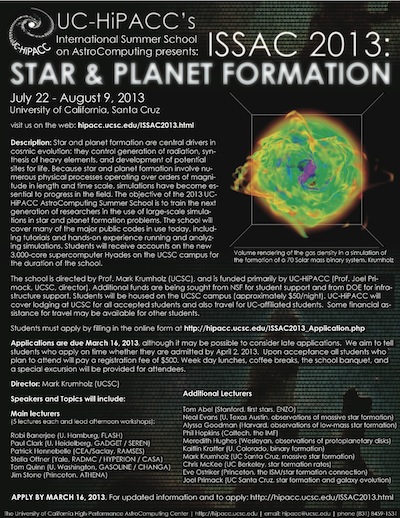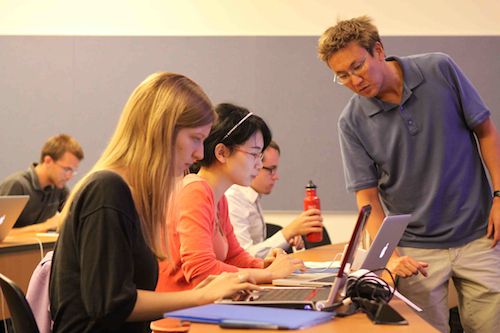- 2014-12-18: UC-HiPACC Funding Discontinued
- 2014-12-03: December 2014 AstroShort: Wild Weather on WASP-43b
- 2014-11-23: Do jets spread Ebola? So long, Smokey—or die; Arctic bad news; souping up clouds; modeling A-bombs; where’s the oil?
- 2014-11-21: Calling all cosmic rays! No snack for Milky Way’s black hole. Why do we even exist?
- 2014-11-19: Obsolescence of humans, meaning of life, invention and genius
- 2014-11-13: November 2014 AstroShort: Mercury: Snow Globe Dynamo?
- 2014-10-27: October 2014 AstroShort: Without a Trace — Almost
- 2014-10-26: Bioinformatics fight Ebola; cybertools in Hong Kong; data-mining Exxon Valdez; Johnny Depp; & computational sarcasm
- 2014-10-20: Neutrinos and planets, black holes, oh my
- 2014-10-17: Coding magic, giving back, and dreamforcing
- 2014-09-19: September 2014 AstroShort—Separated at Birth: Finding our Sun’s Long-Lost Siblings?
- 2014-09-16: Did you know…?
- 2014-08-31: Why Sibling Stars Look Alike: Early, Fast Mixing in Star Birth Clouds
- 2014-08-25: August 2014 AstroShort: ’Smoking Gun’ for Stellar Explosion Mystery
- 2014-08-04: July 2014 AstroShort: Magnetically Levitating Black Holes
- 2014-05-22: May 2014 AstroShort: Drying Out the Moon?
- 2014-04-16: April 2014 AstroShort: Not-So-Rare Earths
- 2014-03-05: March 2014 AstroShort: Discovered: Stellar Dinosaurs!
- 2014-02-01: January 2014 AstroShort: A Black Hole is Born
- 2014-01-22: December 2013 AstroShort: AGORA — Seeing the Invisible Elephant
- 2013-11-03: November 2013 AstroShort: HAWC-Eye on the Sky
- 2013-10-31: The Near-Field Deep-Field Connection Conference
- 2013-10-09: UC-HiPACC’s Fall 2013 & Winter 2014 Grant Application Period is Closed.
- 2013-09-26: September 2013 AstroShort: Measuring Olbers’s Paradox
- 2013-05-24: May 24, 2013: Detection of the cosmic gamma ray horizon: Measures all the light in the universe since the Big Bang
- 2013-05-10: May 2013 AstroShort: Planck: Revising the Universe
- 2013-03-21: March 2013 AstroShort: Planets Amidst the Noise
- 2013-03-18: UC-HiPACC’s Spring & Summer 2013 Grant Application now open!
- 2013-03-12: UC-HiPACC 2013 Summer School: "Star and Planet Formation"
- 2013-03-01: UC-HiPACC—The First Three Years: 2010–2012
- 2013-02-13: February 2013 AstroShort: Milky Way: Cosmic Cannibal!
- 2012-12-20: December 2012 AstroShort: Planet Formation: More Questions Than Answers
- 2012-10-30: October 2012 AstroShort: Disk Galaxies: Settling for Beauty with Age
- 2012-07-06: AstroInformatics 2012
- 2012-06-10: First Science Journalism Boot Camp in Computational Astronomy Held at UCSC, June 2012
- 2011-10-10: Explosive Astrophysics 2011
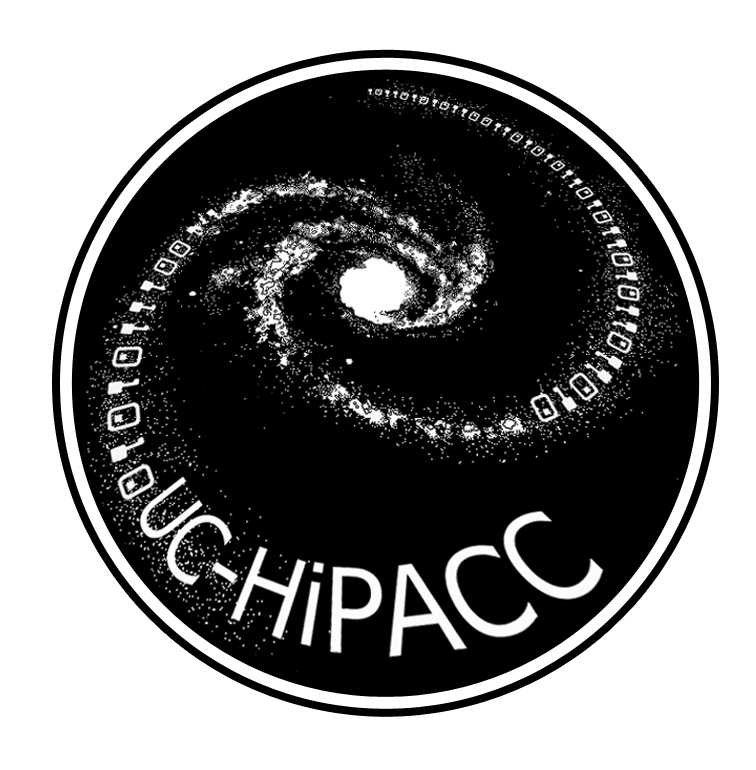
Funding has not been renewed for 2015 and beyond for the five-year-old University of California High-Performance AstroComputing Center (UC-HiPACC). UC-HiPACC’s major programs are therefore suspended. Alternative sources of funding are now being sought. Meantime, a No-Cost Extension to the grant has been approved through March 31, 2015, to support limited operations, including the pioneering AGORA research effort, preparation of a five-year report, and crafting of proposals for outside support. Pending receipt of alternative funding, some suspended programs may be resumed. For details, see UC-HiPACC press release.
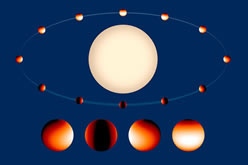
Just in: Weather report for a ‘hot Jupiter’ 260 light-years away: more hellish than Mercury (iron would melt into puddles), because it is more humid—yes, there is water vapor in its atmosphere. And watch out for those howling scorching winds… Read “Wild Weather on WASP-43b,” UC-HiPACC’s latest AstroShort. Find us on Facebook and follow us on Twitter.

 Calling all cosmic rays…. Calling all cosmic rays…
Calling all cosmic rays…. Calling all cosmic rays…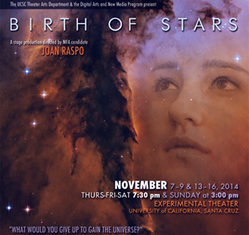
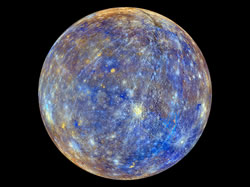 Mercury seen close-up from MESSENGER, with colors enhanced to emphasize the chemical, mineralogical, and physical differences among its surface rocks. Credit: NASA
Mercury seen close-up from MESSENGER, with colors enhanced to emphasize the chemical, mineralogical, and physical differences among its surface rocks. Credit: NASARead the AstroShort Mercury: Snow Globe Dynamo?
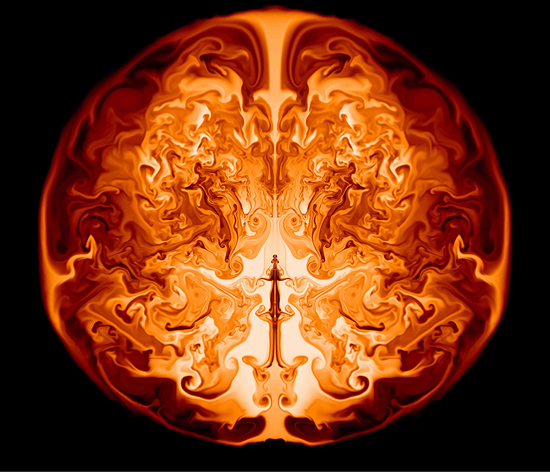 This image is a slice through the interior of a supermassive star of 55,500 solar masses. This snapshot shows a moment one day after the onset of the explosion, when the radius of the outer circle would be slightly larger than that of the orbit of the Earth around the sun. Credit: Ken Chen, UC Santa Cruz
This image is a slice through the interior of a supermassive star of 55,500 solar masses. This snapshot shows a moment one day after the onset of the explosion, when the radius of the outer circle would be slightly larger than that of the orbit of the Earth around the sun. Credit: Ken Chen, UC Santa CruzRead the AstroShort Without a Trace — Almost
 Model of vesicle adhesion, rupture and island dynamics during the formation of a supported lipid bilayer featured on the cover of the journal Soft Matter. Credit: Peter Allen
Model of vesicle adhesion, rupture and island dynamics during the formation of a supported lipid bilayer featured on the cover of the journal Soft Matter. Credit: Peter AllenRead the AstroShort Separated at Birth: Finding our Sun’s Long-Lost Siblings?
August 31, 2014 — Early, fast, turbulent mixing of gas within giant molecular clouds—the birthplaces of stars—means all stars formed from a single cloud bear the same unique chemical “tag” or “DNA fingerprint,” writes computational astronomers at University of California, Santa Cruz in the journal Nature, published online on August 31, 2014. Could such chemical tags help astronomers identify our own Sun’s long-lost sibling stars? Read the UC-HiPACC press release at http://hipacc.ucsc.edu/PressRelease/sibling-stars.html and watch the movies!

Two 11-second movies shows a computational simulation of a collision of two converging streams of interstellar gas, leading to collapse and formation of a star cluster at the center.
Whodunit? A brilliant flash of ultraviolet light from supernova SN 2013cu in a galaxy 360 million light-years away in the constellation Boötes solved an enduring mystery about the origins of massive exploding stars called Type IIb core-collapse supernovae. Thanks to the intermediate Palomar Transient Factory (iPTF) pipeline, the perp of Type IIb supernovae has been identified as Wolf-Rayet. “This is the smoking gun!” exulted Peter Nugent, head of the Computational Cosmology Center at Lawrence Berkeley National Laboratory. Read the AstroShort ’Smoking Gun’ for Stellar Explosion Mystery.
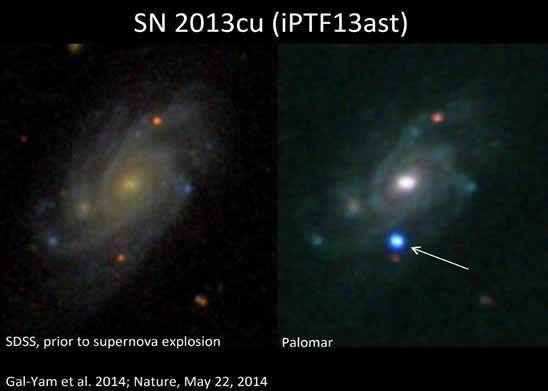
While observing a galaxy known as UGC 9379 (left; image from the Sloan Digital Sky Survey) about 360 million light-years from Earth, the iPTF team used a 1.2-meter robotic telescope at Palomar Observatory to discover a new supernova, SN 2013cu (right, marked with an arrow; image from a 1.5-meter robotic telescope, also at Palomar).
Loud and twisted: some supermassive black holes at the centers of galaxies have twisted magnetic fields so powerful they counteract the colossal pull of their gravity—allowing clouds of accreting gas or other objects literally to levitate temporarily in place above the black hole instead of plunging into the maw. That’s the conclusion of one UC Berkeley researcher and three coauthors after comparing their computational model to empirical measurements of not just one or two, but of 76 supermassive black holes in loud radio galaxies and blazars. The new findings may mean that theorists must re-evaluate their understanding of how supermassive black holes behave. Read the AstroShort “Magnetically Levitating Black Holes.”
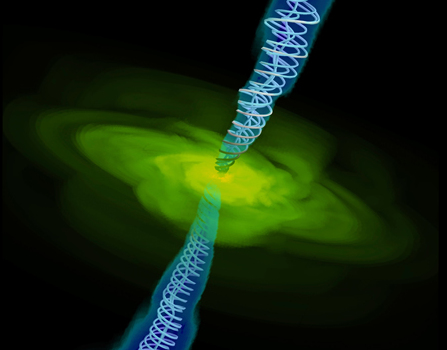
A computer simulation shows gas (yellow) falling in the direction of a central black hole (too small to be seen). Twin jets (blue), strongly focused by spiral magnetic field lines, shoot out towards the top and bottom, perpendicular to the plane of the rotating accretion disk. Credit: Alexander Tchekhovskoy/LBNL
Moon rocks brought back by the Apollo astronauts revealed that the lunar mineral apatite is everywhere, from the ancient lunar highlands to the young lunar maria (lava seas). Much of it is rich in hydrogen. Taking hydrogen as a proxy for water, the evidence suggested that the material from which the Moon formed might have been as wet as that which formed Earth. Apatite became widely adopted as a yardstick for measuring hydrogen—and thus water—in the Moon. But a new computational model of how apatite crystalized from lunar magmas, devised by Jeremy W. Boyce at UC Los Angeles and four coauthors, now reveals that apatite, the mineral on which scientists have long relied, “cannot be trusted.” Read the AstroShort “Drying Out the Moon?”

Photomicrograph of Apollo 11 lunar sample 10044,644 maps density of its polished surface: denser materials reflect more electrons and look lighter gray. Pinkscale version of image highlights density variations for a crystal of apatite. Credit: Jeremy Boyce, UCLA
If the stars observed by NASA’s Kepler spacecraft are statistically representative of those in our own solar neighborhood of the Milky Way galaxy, then “Earth-size planets are common around nearby Sun-like stars,” conclude Erik A. Petigura and Geoffrey W. Marcy from the University of California, Berkeley and Andrew W. Howard from the University of Hawaii. They were led to that conclusion by a monumental statistical analysis of Kepler data completed with the help of the Carver supercomputer at the Department of Energy’s (DOE’s) National Energy Research Scientific Computing Center (NERSC). Read the AstroShort “Not So Rare Earths”.
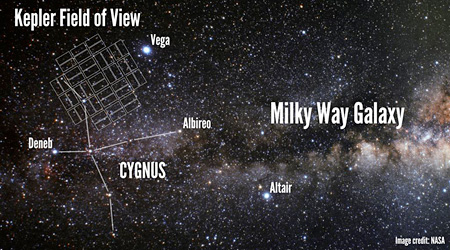
Field of view of the Kepler space telescope, located in the constellation Cygnus, just above the plane of the Milky Way Galaxy. Credit: NASA
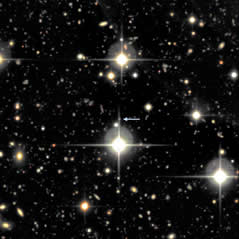
Astrophysicists had unusual ringside seats to the birth of a black hole in an inconspicuous galaxy relatively nearby, watching across all wavelengths from initial gamma ray burst and optical flash through fading afterglow. Read AstroShort
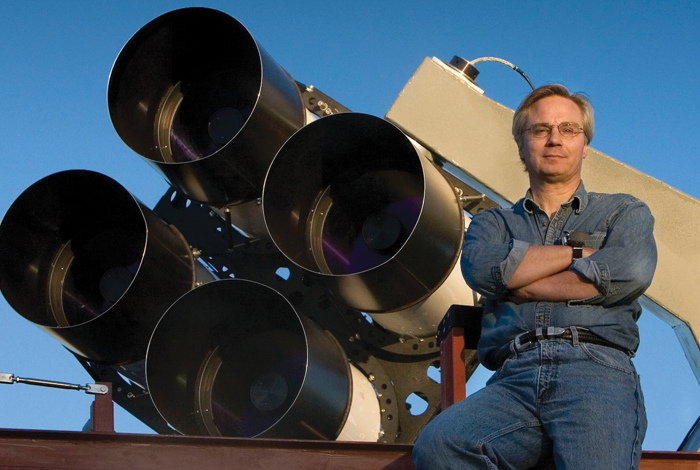
Los Alamos National Laboratory astrophysicist Tom Vestrand poses with the fast-slew array of telescopes for RAPTOR (RAPid Telescopes for Optical Response) system. RAPTOR is an intelligent visual system that scans the skies for optical anomalies and zeroes in on them when it detects them. This unique capability allowed astronomers to witness the birth of a black hole in the constellation Leo.
Why should astrophysicists believe computational simulations about the origins of the universe and evolution of galaxies? After all, results from different codes differ. Now, a major international effort Project AGORA is systematically comparing major computational codes to tease out the real astrophysics…. Read AstroShort
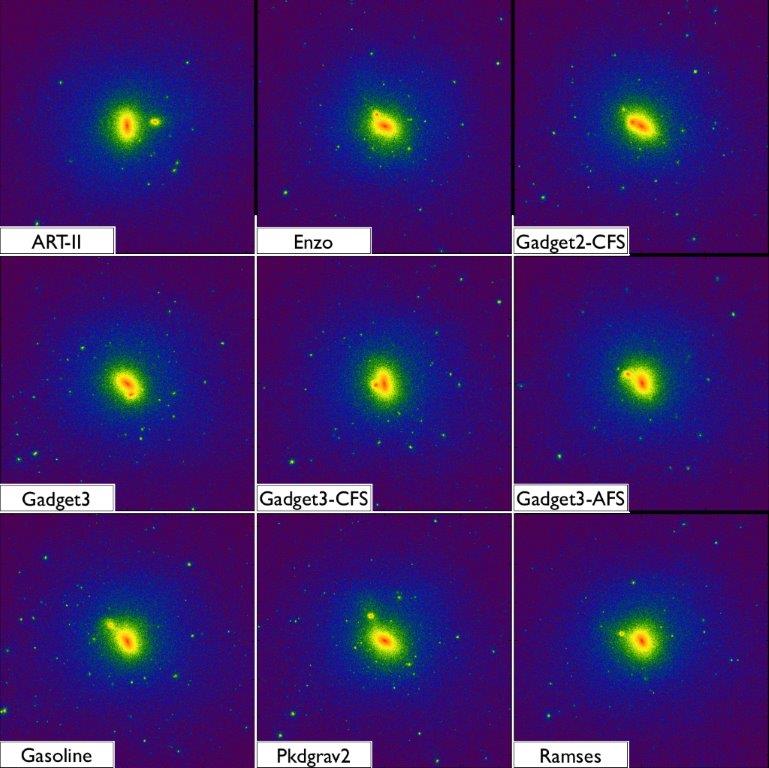
Differences in supercomputer simulations to be compared in the AGORA project are clearly evident in this test galaxy produced by each of nine different versions of participating codes using the same astrophysics and starting with the same initial conditions.
A telescope made of water—HAWC, high in Mexico’s mountains—has begun monitoring the heavens to capture the Universe’s most violent events. Read AstroShort

Array of 115 water tanks of the High-Altitude Water Cherenkov (HAWC) Observatory as it appeared on September 13, 2013. When completed in early 2014, it will have 300 tanks. HAWC is at an altitude of 4,100 meters on the flanks of the Sierra Negra volcano near Puebla, Mexico. It is an international collaboration of over 20 institutions in the U.S. and Mexico. In the background is Pico d’Orizaba, a dormant volcano with an elevation of 5,635 meters (the highest peak in North America outside of Alaska). Credit: Benemérita Universidad Autónoma de Puebla
The Southern California Center for Galaxy Evolution (CGE) and the University of California High-Performance AstroComputing Center (HiPACC) are bringing together theorists and observers for a three-day conference on the Near-Field Deep-Field Connection. Topics to be covered include (1) local relics of reionization, (2) connections between first stars and local metallicity, (3) the evidence for and impact of IMF variation, (4) the CGM of the Milky Way and beyond, (5) dwarf galaxies at high and low z, and (6) star-formation histories near and far.
The Near-Field Deep-Field Connection February 12-14, 2014 Beckman Center of the National Academies, Irvine, CA
For More Information
The next application window will open in early May.
Streaming through deep space today in some form is almost all the light that all galaxies have ever radiated. Capturing those precious ancient photons of extragalactic background light allows astronomers to deduce details about the grand story of cosmic origin. Read AstroShort.

Energetic gamma rays (dashed lines) from a distant blazar strike photons of extragalactic background light (wavy lines) in intergalactic space, annihilating both gamma ray and photon. Different energies of EBL photons waylay different energies of gamma rays, so comparing the attenuation of gamma rays at different energies from different spacecraft and ground-based instruments indirectly measures the spectrum of EBL photons. Credit: Nina McCurdy and Joel R. Primack/UC-HiPACC; Blazar: Frame from a conceptual animation of 3C 120 created by Wolfgang Steffen/UNAM
How much light has been emitted by all galaxies since the cosmos began? The Universe is suffused in a bath of almost every photon (particle of light) from ultraviolet to far infrared wavelengths ever radiated by all galaxies that ever existed throughout cosmic time. An accurate measurement of this extragalactic background light (EBL) is as fundamental to cosmology as measuring the heat radiation left over from the Big Bang (the cosmic microwave background) at radio wavelengths. A new paper, called "Detection of the Cosmic γ-Ray Horizon from Multiwavelength Observations of Blazars," by Alberto Dominguez and six coauthors, just published by the Astrophysical Journal—based on observations spanning wavelengths from radio waves to very energetic gamma rays, obtained from several NASA spacecraft and several ground-based telescopes—describes the best measurement yet of the evolution of the EBL over the past 5 billion years.
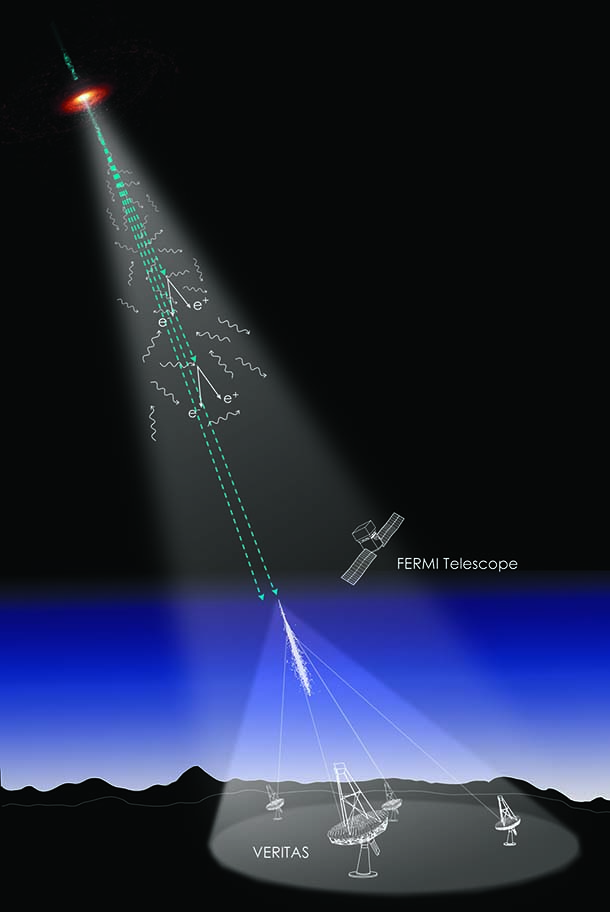
The attached figure illustrates how energetic gamma rays (dashed lines) from a distant blazar strike photons of extragalactic background light (wavy lines) and produce pairs of electrons and positrons.
The Universe is about 100 million years older than perviously estimated and is expanding slightly more slowly; it also has slightly more dark matter and a bit less dark energy than previously suspected.... Read AstroShort.

Cray XE6 supercomputer Hopper, named for 20th-century computer scientist Grace Hopper, performed most of the Planck calculations. Hopper is at the DOE National Energy Scientific Computing Center at Lawrence Berkeley National Laboratory. Credit: Roy Kaltschmidt
Tau Ceti’s five Earth-sized planets were not supposed to be there. They revealed themselves when Steven S. Vogt, astrophysics professor at UC Santa Cruz, and his collaborators were testing a new noise-analysis method on spectrometer data to calibrate a new computational technique...

The Sun moves around the barycenter (center of mass) of our solar system, depending on the positions of the planets. Detecting barycentric movement of other stars from precision radial velocity (RV) measurements can reveal the presence of Earth-mass planets; the pattern of movement can reveal number, masses, and orbits. Credit: Carl Smith, Rubik-wuerfel
UC-HiPACC will support focused working groups of UC scientists from multiple campuses to pursue joint projects in computational astrophysics by providing funds for travel and lodging. At the heart of UC-HiPACC are working groups. These groups will typically consist of collaborations of two to a dozen people, in practice mostly graduate students and post-doctoral fellows, from two or more UC campuses or DOE labs. Periods will typically range from a few days to a few months. UC-HiPACC funding can provide career-shaping opportunities for students in which they learn from other leading faculty members, master skills not taught on their own campus, line up writers for crucial letters of recommendation, and form other contacts and alliances that can powerfully shape their future careers. Some collaborations will also bring together senior astrophysicists with computer scientists and engineers to extend the state of the art in computation and data analysis. More Information
UPDATE: Deadline extended to Saturday, March 23 - Star and planet formation are central drivers in cosmic evolution: they control generation of radiation, synthesis of heavy elements, and development of potential sites for life. Because star and planet formation involve numerous physical processes operating over orders of magnitude in length and time scale, computational simulations have become essential to progress in the field.
The objective of the 2013 UC-HiPACC AstroComputing Center advanced International Summer School on AstroComputing (ISSAC) is to train the next generation of researchers—current graduate students and postdoctoral fellows—in the use of large-scale simulations for problems in star and planet formation. The three-week school will cover many of the major public codes in use today, including tutorials and hands-on experience running and analyzing simulations. Students will receive accounts on the new 3,000-core supercomputer Hyades on the UCSC campus for the duration of the school.
UC-HiPACC—The First Three Years: 2010–2012 summarizes the Center's principal programs, activities, and achievements during its first three years, 2010-2012, as well as some looks ahead for 2013.
In June, the supermassive black hole Sgr A* at the center of the Milky Way is about to capture and gobble a gas cloud. Astronomers are eagerly waiting to watch the feeding frenzy—and see how well its details were predicted by computational simulations.
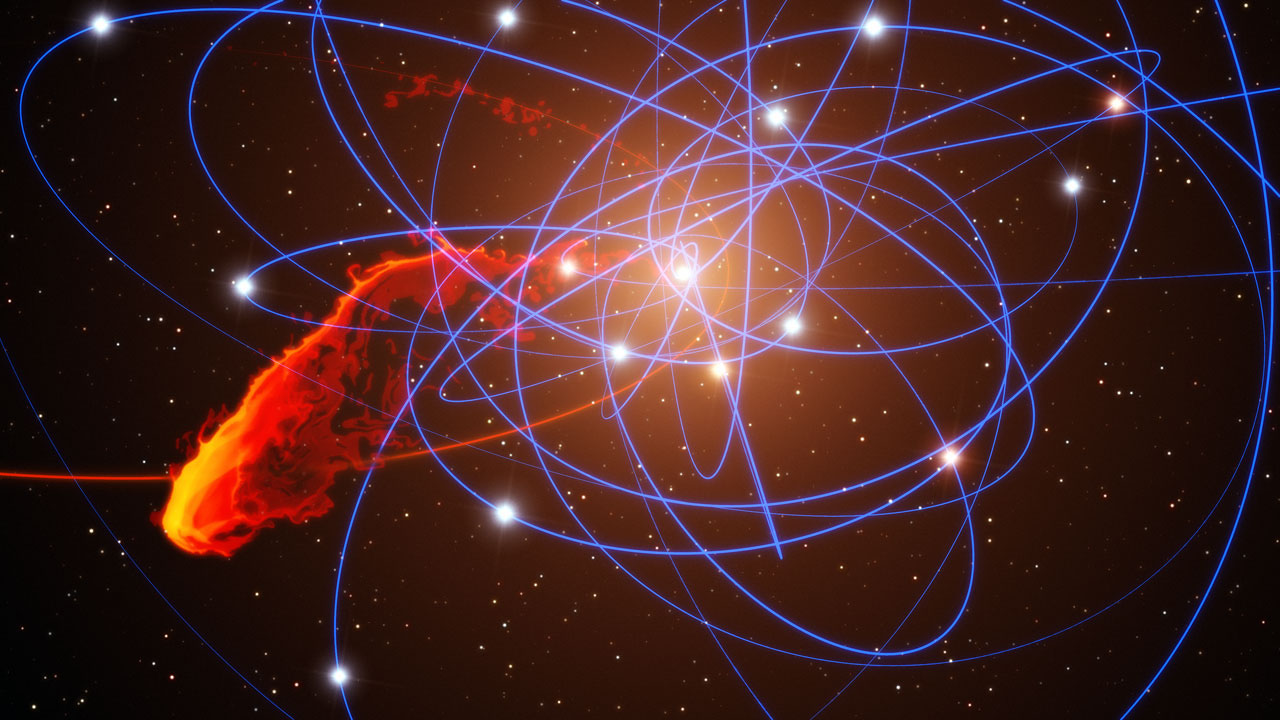
Simulations of the dust and gas cloud G2 (orange and yellow) on its orbit around the Milky Way cen- tral black hole Sgr A* (invisible near center). White objects and orbits depict hot young stars whipping around the supermassive black hole. Credit: M. Schartmann and L. Calcada, European South- ern Observatory and Max-Planck-Institut fur Extrater- restrische Physik
Now that NASA's Kepler spacecraft and various ground-based observations have confirmed 847 planets as existing around 642 stars within several hundred light-years of our Sun, how has their discovery altered astrophysicists' theories about how planetary systems form around stars?
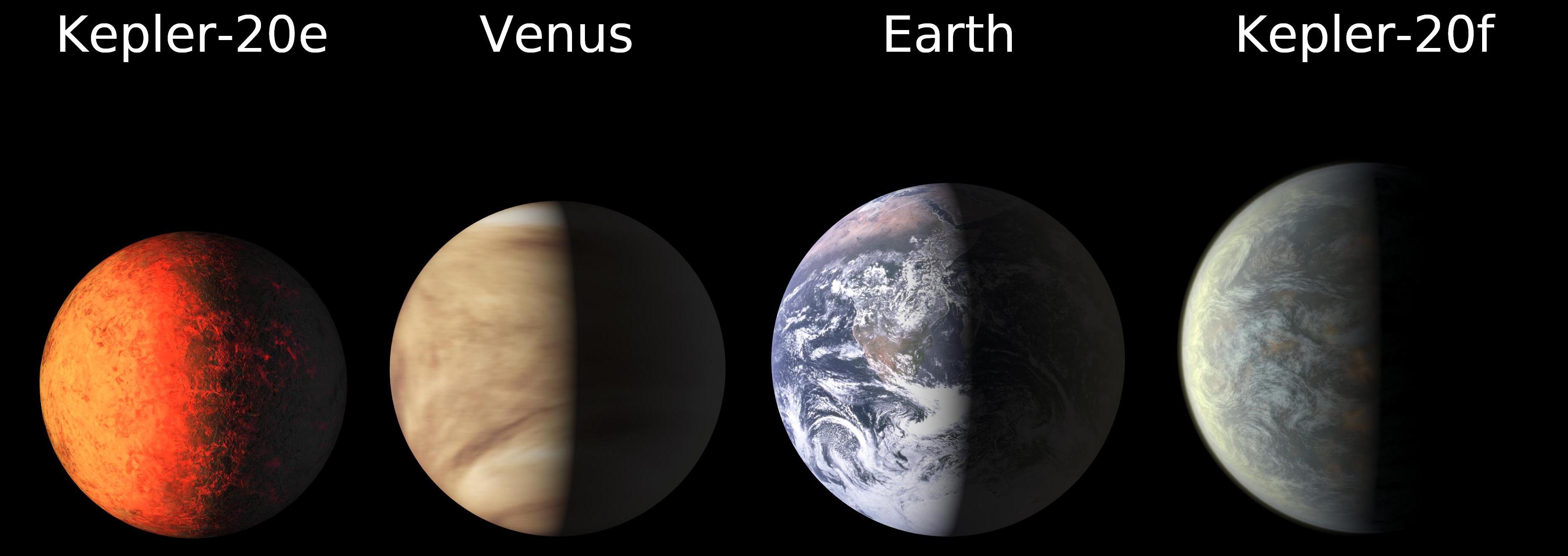
The first Earth-sized planets were found in December 2011 by NASA’s Kepler mission around a sun-like star Kepler-20. Kepler-20e is slightly smaller than Venus with a radius 0.87 that of Earth; Kepler-20f is a bit larger than Earth at 1.03 times the radius of Earth. Both are rocky but with scorching temperatures, as their “years” (orbital periods) are only 6.1 and 19.6 days, respectively. Three larger, likely gaseous, planets also circle Kepler-20. Image credit: NASA/Ames/JPL-Caltech
Spectroscopic observations of distant galaxies taken with the 10-meter telescopes at the W. M. Keck Observatory on Hawaii, when combined with images from the Hubble Space Telescope plus supercomputer simulations to interpret the observations, reveal a beautiful surprise about disk galaxies.
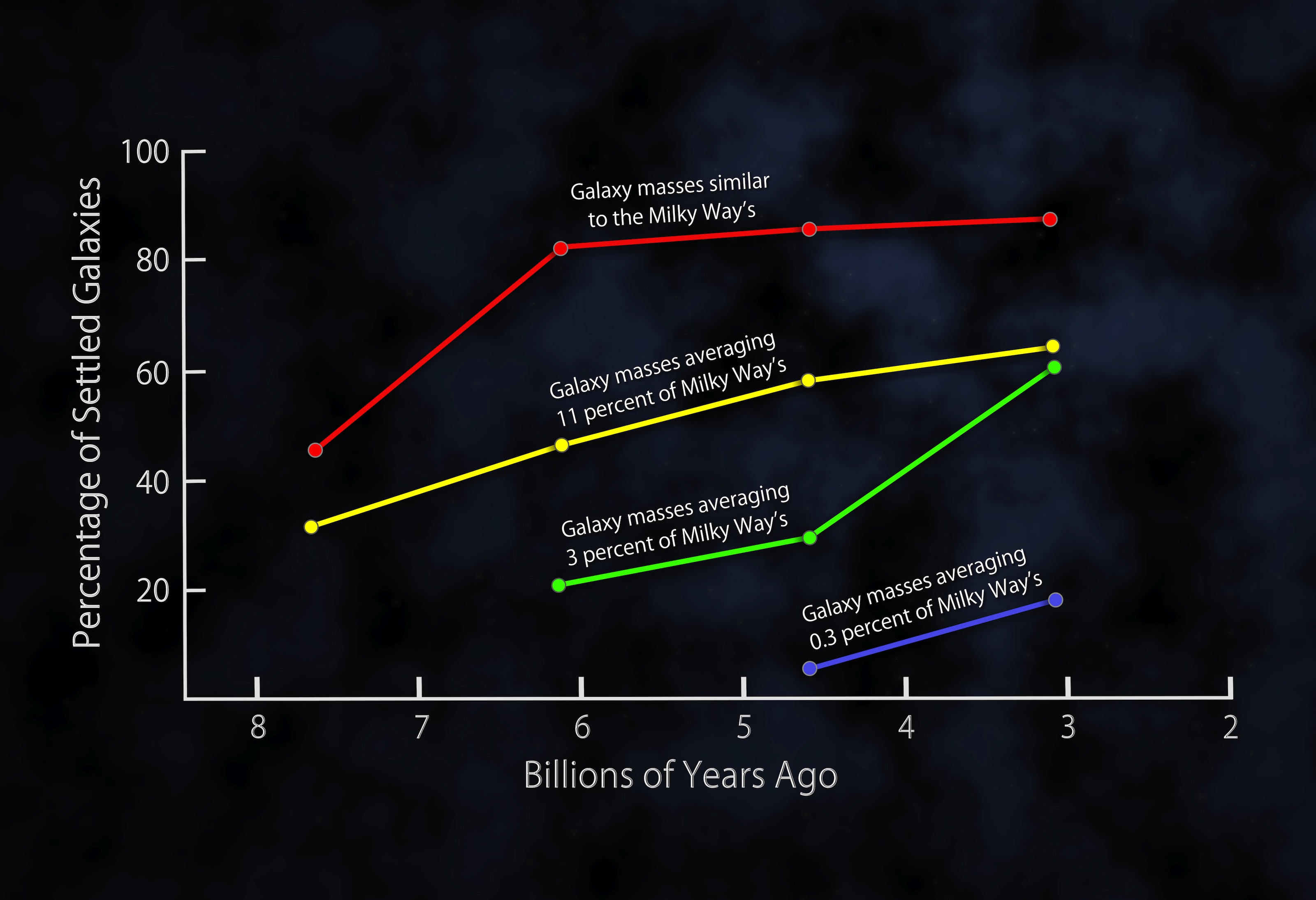
This plot shows the fractions of settled disk galaxies in four time spans, each about 3 billion years long. There is a steady shift toward higher percentages of settled galaxies closer to the present time. At any given time, the most massive galaxies are the most settled. More distant and less massive galaxies on average exhibit more disorganized internal motions, with gas moving in multiple directions, and slower rotation speeds. Credit: NASA/Goddard Space Flight Center
AstroInformatics—data mining for computational astronomy—was the special topic featured at the 2012 International Summer School on AstroComputing, held on the campus of the University of California, San Diego (UCSD), July 9–20. Hosted by the San Diego Supercomputer Center (SDSC) and the University of California High-Performance AstroComputing Center (UC-HiPACC), the two-week summer school was open to graduate students and post-doctoral fellows.
“Today’s telescopes are generating huge amounts of new information about the universe – in some cases by the second,” said Michael Norman, director of SDSC and a world-renowned astrophysicist. “Astronomers will need to know how to leverage the capabilities of data-intensive supercomputers to analyze all this data efficiently while bringing these observations and simulations into a common framework.”
“This summer school will empower astronomers to compare massive observational data with massive theoretical outputs,” said Joel R. Primack, director of UC-HiPACC, a consortium of nine UC campuses and three Department of Energy (DOE) laboratories: Lawrence Berkeley National Laboratory, Lawrence Livermore National Laboratory, and Los Alamos National Laboratory. “‘Big Data’ is a challenge for many fields of science and engineering. People who have learned how to use data-intensive supercomputers will be increasingly valuable.”
 SanDiego Supercomputer Center where sessions of the 2012 International Summer School on AstroComputing convened July 9–20. (Credit: Alan Decker)
SanDiego Supercomputer Center where sessions of the 2012 International Summer School on AstroComputing convened July 9–20. (Credit: Alan Decker)Hands on A key feature of the UC-HiPACC summer schools has been the access by all students to powerful supercomputers, and afternoon workshops for learning how to use relevant astronomical data sets and simulations. Students attending the 2012 UC-HIPACC summer school were issued user accounts on SDSC’s new Gordon supercomputer, which began operation in January. The result of a five-year, $20 million National Science Foundation (NSF) grant, Gordon can process data-intensive problems about 10 times faster than other supercomputers because it is the first such system to employ massive amounts of flash-based memory – common in smaller devices such as cellphones or laptop computers – instead of slower spinning disks (see a write-up about Gordon at http://www.sdsc.edu/News%20Items/PR120711
_gordon.html and its full specifications here).
Lectures on many aspects of AstroInformatics were given by leading experts [see sidebar].
Application and expenses Students stayed in Conference Housing near SDSC on the UCSD campus (approximately $50/night). UC-HiPACC will cover lodging and travel expenses for UC-affiliated students; some financial assistance was available for other students.
Past summer schools This is the third UC-HiPACC International Summer School on AstroComputing. The 2010 school, held at UC Santa Cruz, was on galaxy simulations (archived program is at http://hipacc.ucsc.edu/html/2010SummerSchool_
archive.html ). The 2011 school, held at UC Berkeley and Lawrence Berkeley National Laboratory, was on computational explosive astrophysics (archived program is at http://hipacc.ucsc.edu/html/ISSAC_Home.php ).
For further information and answers to questions please contact Sue Grasso in the UC-HiPACC office (email: hipacc@ucsc.edu , phone: 831 459-1531).
Nearly two dozen of the world’s top science and engineering journalists—whose publications and productions collectively reach more than 10 million readers and viewers worldwide—converged onto the campus of the University of California at Santa Cruz for the first “boot camp” on astronomy to be held on the West Coast.
“Computational Astronomy: From Planets to Cosmos,” was an intense three-and-a-half-day backgrounder for practicing science or engineering journalists from all media—print, online, broadcast, social media, and film—whether on staff or freelance. The UC-HiPACC boot camp, held June 24-27, was also the first ever to be offered specifically on astrocomputing. Monday and Tuesday were two full days of intensive “mini-courses” View the CAJCB website
What do you get when you combine 28 brilliant students with 15 top experts at a UC campus and a Department of Energy laboratory, with a major supercomputer? The two-week 2011 UC-HiPACC International Summer School on AstroComputing (ISSAC)!
The focus of the 2011 UC-HiPACC International Summer School on AstroComputing (ISSAC). Fast-spinning pairs of neutron stars that spiral into each other until they collide or tidally tear one another apart, stars that catastrophically explode in stellar thermonuclear annihilation, objects that emit bursts of energetic gamma rays, and other transient acts of energetic stellar violence.
Twenty-eight graduate students and post-doctoral fellows spent two weeks learning from some of the world's top experts in computational explosive astrophysics during intensive sessions on "Computational Explosive Astrophysics" held at the Lawrence Berkeley National Laboratory (LBNL) and the campus of the University of California at Berkeley from July 18–July 29, 2011. ISSAC 2011 was sponsored mainly by the University of California High-Performance AstroComputing Center (UC-HIPACC ), with additional funding from the Department of Energy.
Theory and practice
Morning sessions at LBNL were tutorials either on astronomical theory or specific computational techniques; topics ranged from "Magnetohydrodynamics and Jet-Powered Supernovae," "Self Gravity," and "Compact Object Mergers" to "Introduction to AMR [Adaptive Mesh Refinement]" and "Modeling Type Ia Supernovae and Flame Physics." Over the two weeks, morning tutorials were led by 15 faculty. Four were from UC campuses, four from LBNL, and seven from other U.S. universities [see sidebar].
Afternoon sessions were hands-on workshops to guide students in running such codes as CASTRO, FLASH, GRID, and VisIt, and modules for radiation transport and nuclear burning. Students were given accounts and computing time on the Hopper-II supercomputer at the DOE National Energy Research Scientific Computing (NERSC) Center at LBNL, to gain hands-on experience in visualizing simulations at a leading supercomputing facility.
For relaxation, students and faculty enjoyed several organized group lunches and an evening banquet, and also attended a performance of "Two Gentlemen of Verona" at Berkeley's famous California Shakespeare Theater (Cal Shakes).
ISSAC 2011 was attended by 11 students from UC campuses, Lawrence Berkeley Laboratory, or Caltech; 16 from 10 U.S. universities outside of California and 1 from Technion (Israel Institute of Technology). Students paid a $250 registration fee; UC-HiPACC covered the travel expenses and accommodations of the UC students and made some travel assistance available to the others as well.
Once and future
Started in 2010, ISSAC is aimed at grad students and postdocs who are currently working in—or actively interested in doing research in—computational astronomy. Topics and locations of the annual summer school rotate among the UC campuses and national laboratories. The California Institute of Technology and Stanford University may also participate in the future. "Galaxy Simulations" was the theme of ISSAC 2010 held on the campus of the University of California at Santa Cruz.
The topic of ISSAC 2012, to be held at the University of California, San Diego, and the San Diego Supercomputer Center, is "AstroInformatics." Details and application information coming soon!
– Trudy E. Bell, M.A.
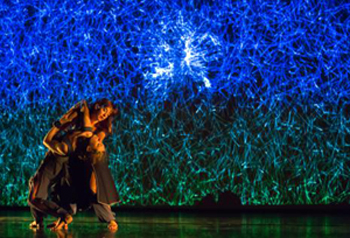 Danceroom spectroscopy. Credit: David Glowacki
Danceroom spectroscopy. Credit: David Glowacki

